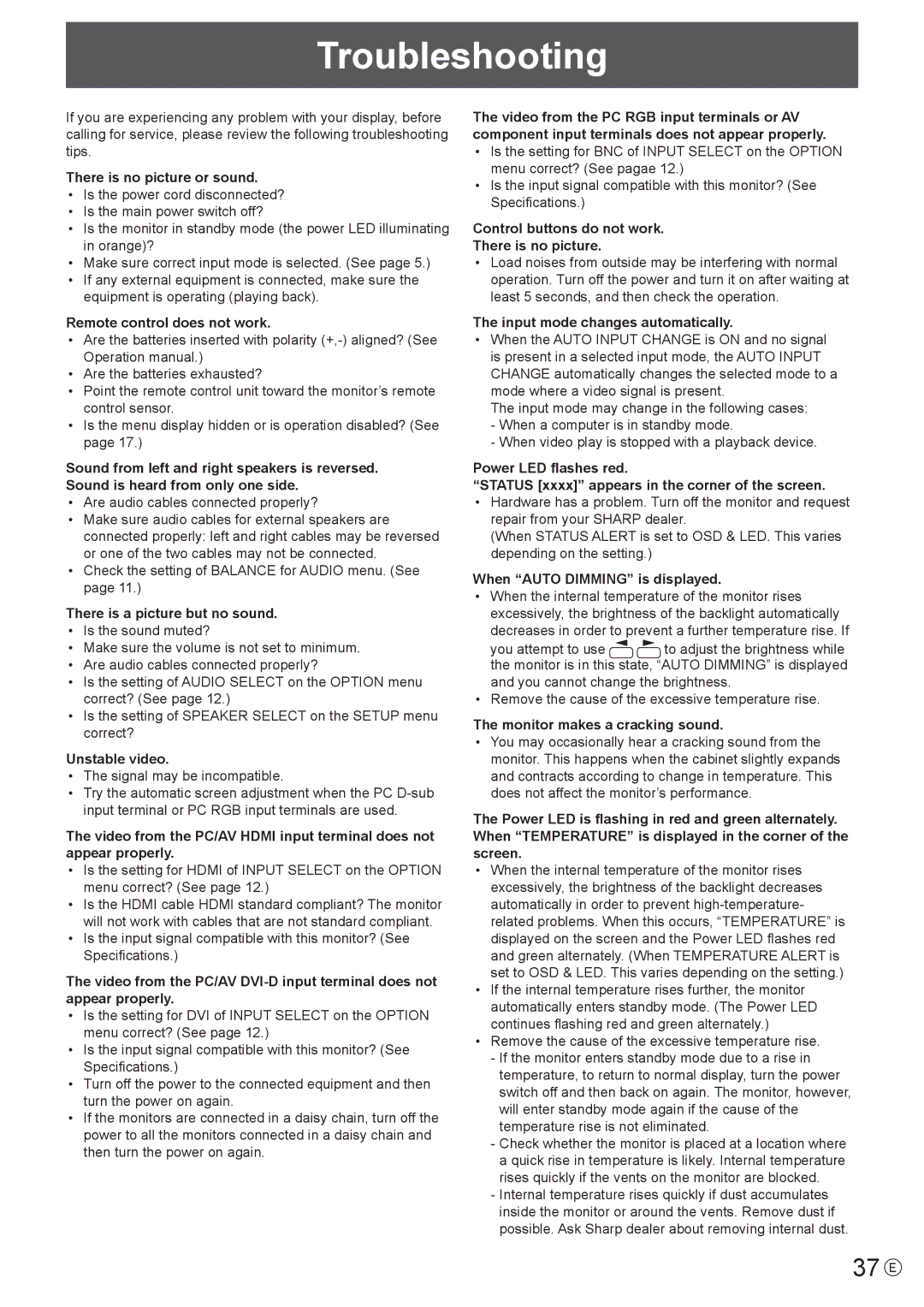If you are experiencing any problem with your display, before calling for service, please review the following troubleshooting tips.
There is no picture or sound.
•Is the power cord disconnected?
•Is the main power switch off?
•Is the monitor in standby mode (the power LED illuminating in orange)?
•Make sure correct input mode is selected. (See page 5.)
•If any external equipment is connected, make sure the equipment is operating (playing back).
Remote control does not work.
•Are the batteries inserted with polarity (+,-) aligned? (See
Operation manual.)
•Are the batteries exhausted?
•Point the remote control unit toward the monitor’s remote control sensor.
•Is the menu display hidden or is operation disabled? (See page 17.)
Sound from left and right speakers is reversed. Sound is heard from only one side.
•Are audio cables connected properly?
•Make sure audio cables for external speakers are connected properly: left and right cables may be reversed or one of the two cables may not be connected.
•Check the setting of BALANCE for AUDIO menu. (See page 11.)
There is a picture but no sound.
•Is the sound muted?
•Make sure the volume is not set to minimum.
•Are audio cables connected properly?
•Is the setting of AUDIO SELECT on the OPTION menu correct? (See page 12.)
•Is the setting of SPEAKER SELECT on the SETUP menu correct?
Unstable video.
•The signal may be incompatible.
•Try the automatic screen adjustment when the PC D-sub input terminal or PC RGB input terminals are used.
The video from the PC/AV HDMI input terminal does not appear properly.
•Is the setting for HDMI of INPUT SELECT on the OPTION menu correct? (See page 12.)
•Is the HDMI cable HDMI standard compliant? The monitor will not work with cables that are not standard compliant.
•Is the input signal compatible with this monitor? (See Specifications.)
The video from the PC/AV DVI-D input terminal does not appear properly.
•Is the setting for DVI of INPUT SELECT on the OPTION menu correct? (See page 12.)
•Is the input signal compatible with this monitor? (See Specifications.)
•Turn off the power to the connected equipment and then turn the power on again.
•If the monitors are connected in a daisy chain, turn off the power to all the monitors connected in a daisy chain and then turn the power on again.
The video from the PC RGB input terminals or AV component input terminals does not appear properly.
•Is the setting for BNC of INPUT SELECT on the OPTION menu correct? (See pagae 12.)
•Is the input signal compatible with this monitor? (See Specifications.)
Control buttons do not work.
There is no picture.
•Load noises from outside may be interfering with normal operation. Turn off the power and turn it on after waiting at least 5 seconds, and then check the operation.
The input mode changes automatically.
•When the AUTO INPUT CHANGE is ON and no signal is present in a selected input mode, the AUTO INPUT CHANGE automatically changes the selected mode to a mode where a video signal is present.
The input mode may change in the following cases:
-When a computer is in standby mode.
-When video play is stopped with a playback device.
Power LED flashes red.
“STATUS [xxxx]” appears in the corner of the screen.
•Hardware has a problem. Turn off the monitor and request repair from your SHARP dealer.
(When STATUS ALERT is set to OSD & LED. This varies depending on the setting.)
When “AUTO DIMMING” is displayed.
•When the internal temperature of the monitor rises excessively, the brightness of the backlight automatically decreases in order to prevent a further temperature rise. If
you attempt to use 
 to adjust the brightness while
to adjust the brightness while
the monitor is in this state, “AUTO DIMMING” is displayed and you cannot change the brightness.
• Remove the cause of the excessive temperature rise.
The monitor makes a cracking sound.
•You may occasionally hear a cracking sound from the monitor. This happens when the cabinet slightly expands and contracts according to change in temperature. This does not affect the monitor’s performance.
The Power LED is flashing in red and green alternately. When “TEMPERATURE” is displayed in the corner of the screen.
•When the internal temperature of the monitor rises excessively, the brightness of the backlight decreases automatically in order to prevent high-temperature- related problems. When this occurs, “TEMPERATURE” is displayed on the screen and the Power LED flashes red and green alternately. (When TEMPERATURE ALERT is set to OSD & LED. This varies depending on the setting.)
•If the internal temperature rises further, the monitor automatically enters standby mode. (The Power LED continues flashing red and green alternately.)
•Remove the cause of the excessive temperature rise.
-If the monitor enters standby mode due to a rise in temperature, to return to normal display, turn the power switch off and then back on again. The monitor, however, will enter standby mode again if the cause of the temperature rise is not eliminated.
-Check whether the monitor is placed at a location where a quick rise in temperature is likely. Internal temperature rises quickly if the vents on the monitor are blocked.
-Internal temperature rises quickly if dust accumulates inside the monitor or around the vents. Remove dust if possible. Ask Sharp dealer about removing internal dust.

